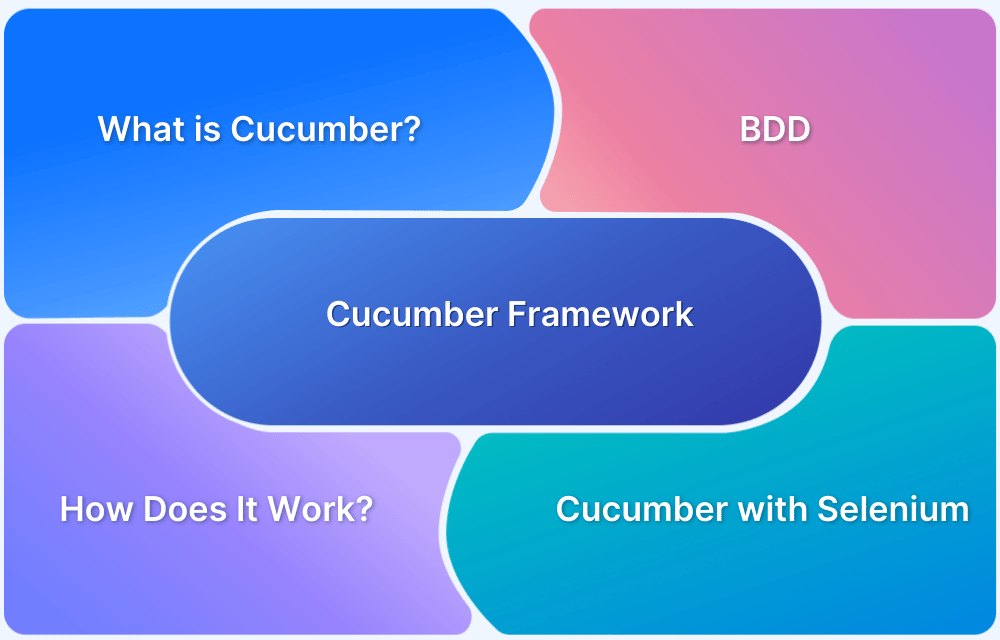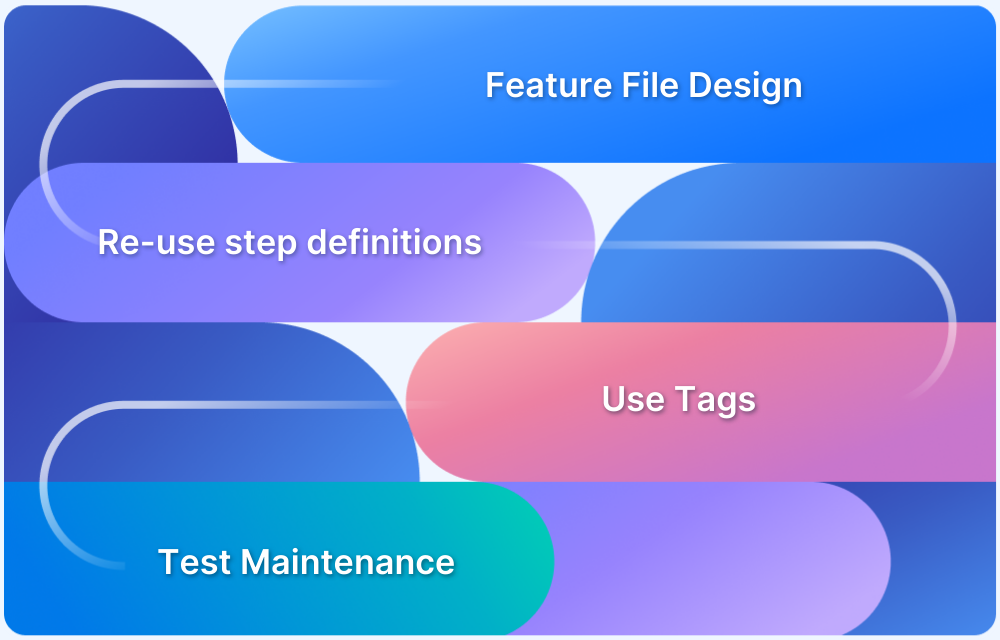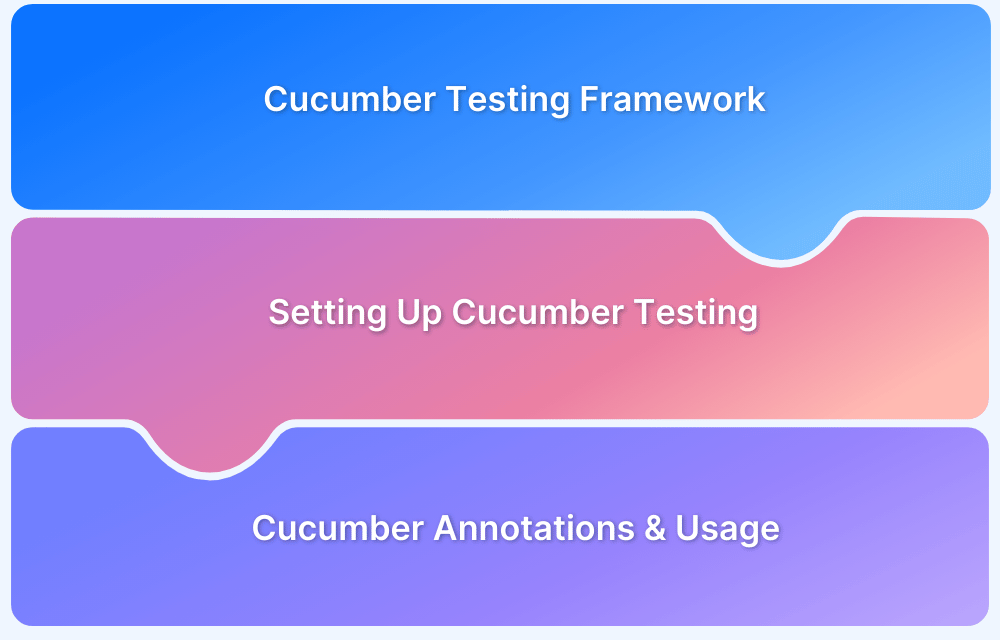Cucumber Testing Framework is among the most widely used testing frameworks for Advanced BDD Test Automation. Capturing screenshots for failed scenarios in Cucumber tests helps testers quickly identify issues and debug effectively. This feature integrates easily with Selenium WebDriver and improves visibility of test outcomes in reports.
Overview
Why Capture Screenshots in Cucumber?
- It helps to visualize test failures instead of relying only on logs.
- It also speeds up root cause analysis during debugging.
How to Capture Screenshots in Cucumber?
- Set up the project using the Cucumber framework
- Implement @After hook in Cucumber to detect failures.
- If a scenario fails, trigger screenshot capture using WebDriver.
- Define the folder for the screenshot to be placed within.
This article will explore how to set up the Cucumber Project and also explain about taking screenshots in Cucumber.
Why is a Screenshot required in Cucumber Testing?
While using Cucumber, it is very important to know why the test is getting failed. One useful way is to include a screenshot of failed step in the test execution report whenever some scenario is failed. Screenshots help in analyzing where the execution is facing problems and improve the debugging process.
Screenshots provide better quality and flexibility while debugging failed scenarios.
How to Set up a Cucumber Project
Let’s first set up the project using the Cucumber framework:
Step 1: Install IDE and Set up Java
You can install any IDE, however, using Eclipse IDE in this example. Also, install the latest version of Java on your system. To ensure that Java is installed on your system, run a quick command in the terminal to check the Java version.
Java -version
Step 2: Create a new Maven Project
To create a Maven project, you must install the Maven Plugin. However, in the latest versions of Eclipse, it comes installed already.
Step 3: Add Maven dependencies to your project
In this step, you have to add several dependencies to your project. Navigate to the pom.xml file in the folder structure and then add the dependencies mentioned below. You can get these dependencies from Maven Repository.
- Cucumber Java
- Cucumber JUnit
- JUnit
- Selenium Java
Step 4: Create a feature file
Navigate to src/test/resources in the folder structure and then create a feature folder. Also, add a feature file in the feature folder there.
Step 5: Install the Cucumber plugin
You can easily install the Cucumber plugin from the Eclipse marketplace. The Cucumber plugin lets the codebase know that you’re creating a Cucumber project.
Step 6: Create Step Definitions
To create Step definitions, navigate to the src/test/java package and then add a step definition folder and file there.
Step 7: Create a Runner Class
Create a class file in the Step Definitions folder and add the runner class script. The runner class will look something like this.
import org.junit.runner.RunWith;
import io.cucumber.junit.Cucumber;
import io.cucumber.junit.CucumberOptions;
@RunWith(Cucumber.class)
@CucumberOptions(features="src/test/resources/Features",
glue={"StepDefinitions"})
public class TestRunner {
}Step 8: Set up .properties file
An extent properties file is necessary for your project because it helps in activating the failed test reports. Before creating the file, you must add a few dependencies, which are the grasshopper extent report adapter plugin and the Extent report library.
Read More: How to Generate Extent Reports in Selenium
To set up these dependencies, add the following scripts inside the pom.xml file.
For the grasshopper plugin, the following dependency is required.
<!-- https://mvnrepository.com/artifact/tech.grasshopper/extentreports-cucumber6-adapter --> <dependency> <groupId>tech.grasshopper</groupId> <artifactId>extentreports-cucumber6-adapter</artifactId> <version>2.1.0</version> </dependency>
Similarly, to add the Extent report library, add the following dependency script.
<!-- https://mvnrepository.com/artifact/com.aventstack/extentreports --> <dependency> <groupId>com.aventstack</groupId> <artifactId>extentreports</artifactId> <version>5.0.4</version> </dependency>
Now, create a .properties file in the src/test/resources. Secondly, add the following text in the plugin section of your test, so that the runner class of Cucumber can recognize that you want to initiate a report with the help of a certain adapter.
@CucumberOptions(plugin = {"com.aventstack.extentreports.cucumber.adapter.ExtentCucumberAdapter:"})How to take Screenshots of Failed Test Cases in Cucumber
Let’s now take a practical implementation on how to take screenshots for failed test cases in Cucumber. In this example, we will create an account on Facebook. However, while doing that, we will write a wrong step to get a failed test. This will demonstrate how to take screenshots of failed test cases in Cucumber.
Step 1: Create a Feature file
@SmokeTest Feature: login facebook Scenario: login facebook and create account Given open safari browser And navigate to Facebook URL And user enters firstname as "BrowserStack User"
Step 2: Create a Hooks file inside the Step Definitions folder
package stepDefinitions;
import org.openga. selenium. OutputType:
public class Hooks extends BaseClass {
@After(order = 1)
public void takeScraenshotOnFailure(Scenario scenario) {
if (scenario.isFailed()) {
TakesScreenshot ts = (TakesScreenshot) driver;
byte[] src = ts.getScreenshotAs(QutputType.BYTES);
scenario.attach(src, "image/png", "screenshot");
}
}
@After(order = 0)
public void tearDown() {
driver.close();
}
}Here, order = 1 denotes that this step will be conducted first, and then the next step order = 2 will take place, thus closing the browser after the screenshot is taken. This step covers the main syntax of taking screenshots of failed tests in Cucumber.
Step 3: Create Page Class file
This step leads us to the Page Object Model in Selenium with the help of Java.
package pages;
import org.openqa.selenium.By;[]
public class Login_Page {
Utils utils= new Utils();
By elements_link = By.xpath("'//div[@class='category-cards']/div[1] /div/div[3]/h5");
By Forms_link = By.xpath("//div[@class='category-cards'div[2]/div/div[3]/h5”);
By textField_firstName = By.xpath("//input[@name=‘firstname123’]”)
public void click_elements() {
utils. clickUsingAction(elements_link) ;
}
public void click Forms() {
utils.click(Forms_link) ;
}
public void EnterFirstName(String firstName ) {
utils.sendKeys(textField_firstName, firstName);
}
}Read More: Page Object Model in Cucumber
Step 4: Create a test runner class file
package runner;
import org.junit.AfterClass;[]
I
@RuniWith(Cucumber.class)
@CucumberOptions(features="./src/test/resources/Features/"
,glue={tepDefinitions"}
,tages = “@SmokeTest"
,plugin = { "pretty", "html: target/cucumber-reports",
"com.aventstack.extentreports.cucumber.adapter.ExtentCucumberAdapter:"}
,monochrome=true
)
public class TestRunner {
}Step 5: Define the location for the screenshot
To place the screenshot in some location, you must define the location of the image using the following code.
#screenshot.dir=test-output/ screenshot.dir=target/ screenshot.rel.path=../
Place this code inside the extent.properties file in the features folder.
After performing all the above steps. You can see the screenshot of the instance where the step failed. The screenshot gets available inside the folder where you have directed it in the extent.properties file.
On a closing note
Screenshots become very useful while analyzing and debugging your tests. In the above example, we have used Cucumber along with Selenium Webdriver in Java to demonstrate the process. Cucumber offers several useful features, one of which is the use of the BDD (Behavior Driven Development) technique. Cucumber itself doesn’t offer the functionality to take screenshots, however, adding a few lines of Java code into the step definition does the work, making it much more efficient in debugging.
For better accuracy is recommended to test on real devices so as to take real user conditions into account. Testing on tools like BrowserStack Automate allows you to test your website on 3000+ device browser combinations, which helps deliver a seamless user experience.






